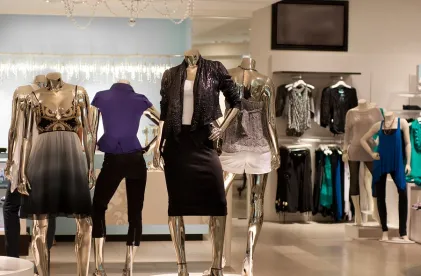The economic fallout of COVID-19 is widespread and immense, and few businesses remain unscathed by fundamental changes to consumer spending. No industry may be more affected than traditional department stores and brick and mortar retailers. Pressures on these businesses are nothing new, and companies across the retail spectrum have worked in recent years, with varying degrees of success, to adapt to the rise of e-commerce and changing consumer preferences. Recently, COVID-19 has exacerbated the struggles of these businesses, as social distancing has made e-commerce the primary, if not the only, sales channel for retail right now.
The impact of COVID-19 on this already weak sector is acute and severe. Even some of those businesses that have adapted to the new market environment lack the balance sheet to survive months of social distancing, state-imposed store closures, and decreased consumer demand. Multiple American flagship retailers, including major department stores, now stand on the verge of bankruptcy, and the “death of the department store” has been well-documented in the media, with numerous retailers already furloughing or laying off staff and closing doors, with more to come.[1]
Why This Matters for Product Manufacturers
If they have not done so already, product manufacturers must prepare for the possibility that their retail partners may face insolvency and file for bankruptcy. Manufacturers cannot sit idly by while department stores—and brick and mortar retailers more generally—struggle through the COVID-19 pandemic. Retailer bankruptcies can lead to deeply discounted liquidation sales and disrupt a product manufacturer’s brand and pricing in the marketplace.
Mass liquidation of retailers’ inventories presents a significant issue for manufacturers. First, liquidation sales can place downward pressure on prices for a manufacturer’s products in the broader market, as competing resellers cut their prices to match those of the insolvent retailer. Additionally, and critically, liquidation sales present an opportunity for unauthorized resellers to purchase enormous quantities of a manufacturer’s products at steeply discounted prices for resale on Internet marketplaces. The result can be a significant and potentially long-lasting interference with the manufacturer’s pricing strategy and sales channels.
Manufacturers must consider preemptive measures that they can implement now to ensure stable pricing in the marketplace both in the present and once the country gets back on its feet post-COVID-19. While these may be unprecedented times, there are several steps a manufacturer can take to eliminate or mitigate exposure in the wake of COVID-19.
Pre-Bankruptcy Actions
Even if a retailer has not yet filed for bankruptcy, there are a variety of strategies a manufacturer should consider to mitigate the potential fallout should the retailer become insolvent. The starting point for a manufacturer would be to conduct a review of any agreements or terms and conditions of sale in place with each specific retailer.
At a minimum, when dealing with an at-risk retailer, the manufacturer can try to condition the fulfillment of an order on the retailer’s advance cash payment for the products. Additionally, a manufacturer may be able to restrict its offering to the at-risk retailer to products that would present a lower risk of market disruption should a liquidation take place. This allows the retailer to continue to sell the brand while mitigating price disruption of marquee products for the manufacturer in the event of bankruptcy.
Moreover, the manufacturer may be able to halt or limit fulfilment of any purchase orders placed by an at-risk retailer. The manufacturer must first consider, however, whether an agreement exists with the retailer obliging the manufacturer to fulfill specified quantities of its products. If there is, the manufacturer must tread carefully but still may be able to demand proof that the manufacturer will be paid before fulfilling new orders.
Finally, if the manufacturer has grave concerns about a retailer, it could preemptively attempt to purchase some or all of its inventory of products back from the retailer. However, this can be complicated if the retailer still owes money for those products, as the retailer may have little incentive to owe less when there is a good chance it will not be making payment anyway. Nevertheless, this can be a good way for a manufacturer to ensure that its products do not end up in the hands of unauthorized, gray market Internet resellers.
Post-Bankruptcy Actions
As the market effects of COVID-19 seem to change daily or even hourly, a manufacturer may not have the opportunity to implement one of the aforementioned strategies before a retailer enters bankruptcy. However, there are still actions the manufacturer can take to minimize the disruption that a retailer’s bankruptcy may have on the manufacturer’s products online thereafter.
For example, a manufacturer can attempt negotiate with the bankruptcy trustee to buy back its products out of the retailer’s inventory. Manufacturers have be able obtain their products back at—or even below—cost, as it provides an influx of cash to the insolvent company. This is especially true in the current environment where social distancing may make it difficult for a bankruptcy trustee to hold a liquidation sale.
Further, even if unable to negotiate with the bankruptcy trustee, the manufacturer may be able to assert legal rights as leverage to prevent the trustee’s sale of the manufacturer’s products elsewhere. A manufacturer may be able to enforce legal claims related to its authorized reseller program (if one exists) or intellectual property rights in a way that impedes or at least complicates the bankrupt retailer’s liquidation plans.
Conclusion
With a number of approaches for a manufacturer to consider to guard itself against the repercussions stemming from the deterioration of the financial health of its retailers, business teams should consult with counsel to understand the risk-reward dynamic for each and determine which is the most appropriate for the brand.
[1] See, e.g., Sapna Maheshwari & Vanessa Friedman, The Death of the Department Store: ‘Very Few Are Likely to Survive,’ NEW YORK TIMES, (April 21, 2020), https://www.nytimes.com/2020/04/21/business/coronavirus-department-stores-neiman-marcus.html.




 />i
/>i
